Official Name
Košice, pronounced [Koshitse]. The name might derive from the Slovak word koša, which means something like "glade". Since Kosice has always been a multiethnic city, the town is known under many different names. Hungarians called the town Kassa, Germans know it as Kaschau (although this name is now almost completely out of use) and for the Poles it's Koszyce. The name is not only used for the town but also for the south-eastern part of Slovakia.
Location

| ||
| Kosice in Slovakia |
Kosice marks the centre of the south-eastern corner of Slovakia. The border to the →Ukraine in the east is less then 200 km away. To →Hungary it's only around 20 km to the south. But to the capital Bratislava it's some 450 km. The town itself occupies the valley of the small river Hornád, which is almost completely encircled by more or less high mountain ranges. The west is characterized by the Slovenské rudohorie (lit.: Slovak Ore Mountains), the west by the smaller but still more then 1,000 m high Slanské vrchy (Slanec Heights). However, the town itself is - at least in the centre - dead plain.
Population
Around 235,000 inhabitants. This makes Kosice the second largest town in the country and by far the largest town in Eastern Slovakia. Therefore it's also the capital of the Košický kraj (Kosice District), which is recently called Kosice Self-governing Region, with around 750,000 inhabitants.
Orientation
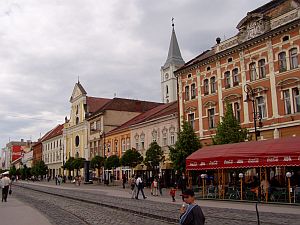
| ||
| The centre of Kosice at the Hlavná |
The north-east of Kosice is characterized by some smaller hills, with some dread modern residential areas sitting on top of them. Right between Staré Mesto (old city centre) and the above-mentioned residential areas lies the žl. st. Košice (train station) and adjacent to the building the Autobusová stanica (Bus terminal). In front of the train station stretches a large square with several tram and bus stations and, next to it on the right, the Mestský park (town park). When walking from the station to west along Mlynská ul. (Mill rd.), it's only around 750 minutes or less then 10 minutes to the centre of the old town - that is the Hlavné nám. (Main Square). The trapezoidal old town area stretches east and west of the Hlavná ul. (Main Road) - a wide and pleasant street running right through the centre. However, especially the southern part of the town centre is rather modern. There you will also find the Tourist information. The town centre is separated from the rest of the town by a long park in the west and the south.
Almost all sights concentrate and the 1,200 m long and around 700 m wide historic centre. Among them several churches, museums and interesting old buildings. To see a good deal of all the sights can take a couple of hours. Besides the sights, the town makes for a pleasant stroll.
History
The area around Kosice was inhabited for a very long time, but it was a Slavic tribe that founded the first larger settlement. After the devastating attack by the Mongols, German merchants were invited to settle in the area, starting at the beginning of the 13th century. The Germans founded another settlement right next to the Slavic one. The place name was first mentioned in 1230. In 1248, Kosice was declared a town with all related privileges. The town prospered and soon became the third most important town in the Kingdom of Hungary. But during the 17th century, Kosice saw several large uprisings in and around the town.
Later on, industrialization reached Kosice. At that time, many of the citizens where Germans. During the Second World War, →Hungary occupied the town and the surrounding area, which shouldn't change until 1945. Then, the Red Army liberated the town - and since Kosice is rather east, the town was one of the first towns in Czechoslovakia to be liberated. And so, Kosice was declared provisional capital of the yet to be newly declared Czechoslovakia. However, as soon as the war was over, capital status was of course shifted back to Prague. Kosice changed a lot during the 1990ies - the entire town centre got a massive facelifting - and the result is worth to have a look at it.
Getting there / transportation
Kosice marks the crossing point of an important north-south route as well as an important east-west route. This makes it easy to get to Kosice quite easily from →Prague in the west and →Kyiv (Kiev) in the east. Furthermore, there are direct trains to →Budapest and to the north to Krakow. For more information on international trains see →Travel Information Slovakia.
Another way to get to the Ukraine from Kosice is to take a bus to Krčava / Vyšné Nemecké in the east. This takes around 2½ hours, the ticket costs 126 Sk. From there it's possible to walk to the nearby border crossing. Behind the border crossing stretches the large town →Uzhgorod. One of the fastest ways to get to the Czech Republic is to take train to Prague via →Olomouc. To the latter it takes 6½ hours. The single trip costs 740 Sk.
As already mentioned above, the historic centre and most shops in Kosice concentrate around the Hlavná (Main Road). In the centre of town, this road splits into two lanes. Parts of the road are off limit for cars. Some important buildings and monuments line up between the two lanes. One of them is the Štátne divadlo (National Opera), which was built at the end of the 19th century and resembles typical Habsburg architecture - similar buildings can be found all the way between the Ukraine , Romania and Austria. The building is still used as an opera. North of the opera - behind the structure so to say - stands a "pest column" built in the 18th century.
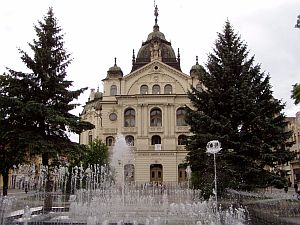
| ||
| Kosice: National Opera |
Walk to the entrance of the opera and turn around - then you'll notice the Dóm sv. Alžbety (Hl Elisabeth Cathedral). This church was finished in 1506 and is nothing less then Slovakia's tallest church. It took around 150 years to complete the late Gothic building, which is easy to understand when looking at the complicated outside as well as the splendid interior. Inside the crypt lies the grave of the former Prince of Transylvania, Duke Ferenc Rákóczi II.. He was the person who led the uprising of Hungarians against the rule of the Habsburgs from 1703 until 1711. He was finally caught and banned to the Ottoman Empire, where he died in 1735.
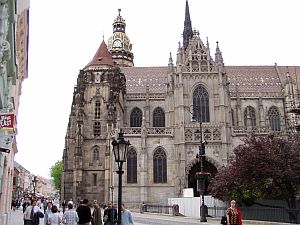
| ||
| Cathedral and tower as seen from Freedom Square |
In front of the cathedral, as seen from the opera, stands the separate Urbanova Veža (city tower). This building dates back to the 14th century, South of the cathedral stretches the long Nám. slobody (Freedom Square) with a small, gothic chapel called Kaplinka sv. Michala right in the middle. A small glas roof on street level gives insight into some archaeological excavations below the square. The area south of the square is already rather modern. The Hlavná is not only popular among visitors, but also for the citizens - countless restaurants and cafés as well as some shops line up along the road. It's definitely worth too to dive into the network of small alleys east of the cathedral. There you'll find some buildings, too - among them the Synagóga and many tiny shops and boutiques.
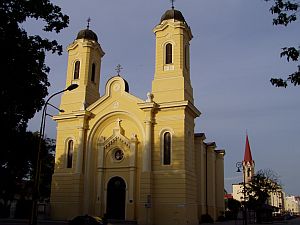
| ||
| Kosice: Church of St Maria |
There are more interesting places to see, making up for a pleasant stroll. The area west of the old town is rather quiet and offers some interesting sights such as the Church of St Maria and a Dominican church (to be seen in the back of the photograph above). Additionally, Kosice has some interesting museums. The largest is the Východoslovenské múzeum (East Slovak Museum) at the northern end of the main road and occupying two separate buildings. The collection includes a gold treasure discovered only in 1935. Furthermore, there is a technology museum, a Rakoczi museum (for which his Ottoman exile building has been brought all the way to Kosice) and some more. Monday is a bad day for museum lovers - all museums close on that day.
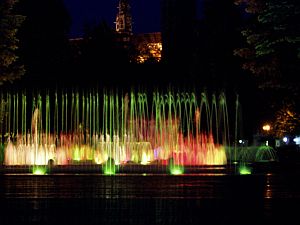
| ||
| Fountain in front of the opera |
Right in the middle of the northern part of the main road runs a tiny channel, equipped with several colourful floodlights. The channel runs all the way to a very small park at the opera. Right in the middle of the park is a large fountain system, flanked by a set of water-resistant speakers. The fountains move - or dance - to the rhythm of the music provided by those speakers. Meanwhile, colours of the fountain's floodlights change accordingly. These fountains might be a little bit too posh but it's still fun to see it working for a while.
Personally I found Kosice more interesting then Bratislava for example - but one of the reasons for that is probably just the compact size of Kosice. Definitely worth a second visit, Kosice is a nice and relaxed place.
The north-eastern corner of Slovakia, where Slovakia meets →Poland and the →Ukraine, is one of the most remote and therefore pristine areas of Slovakia. High mountains, large forests, some fields and some small villages here and there - as well as some medieval towns - make this area a rewarding destination for hiking, cycling or just wandering around. From Kosice, it's some 100 km away. The area is dominated by the Vihorlatské vrchy (Vihorlatsk Heights) - a mountain range with some mountains peaking 1,000 m in height. This mountain range is part of the so-called "Forest Carpathians", which stretches well into the Ukraine.
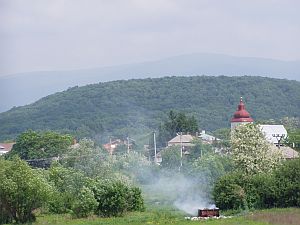
| ||
| The very north-east of Slovakia |
Going north-west from Kosice is worth recommending as well. There you will find the →Tatras - a fascinating landscape. The train ride from Kosice to Poprad between the two Tatras is one of the most charming train rides in Europe, with beautiful mountains and gorges as well as several castles and old towns halfway. Along the road from Kosice to the Tatras lies the Spišský hrad - one of the largest castle ruins in Slovakia, towering majestically on top of a large hill.
At the southern end of the main street stands the obch. dom Dargov - the old department store of Kosice. The same building is home to the tourist information (but there seem to be more then one!), which gladly helps organizing accommodation. In our case, we were sent to a larger place called Jesenského ul., which lies north of the town park and therefore only a few 100 metres away from the train station. There, we paid 460 Sk (€ 12) for a double room .The rooms resemble typical youth hostel facilities but everything seems to be new. The location of course is splendid. Unfortunately I missed asking for the address, but it's hard to miss: Jesenske rd. starts right at the northern end of the park. Cotinue for around 100 meters only and you'll see the place after 100 m or so on the right side.
- www.kosice.sk: Official website of Kosice - doesn't contain much interesting information, but offers regular updates on events in the town. In Slovakian and English.
- www.cassovia.info: Cassovia is the Latin name of the town - and the URL already says it all. English website, well designed but there's still a lack of contents... This might have changed by the time you read this.
Do you have or do you know a good website about Kosice? Don't hesitate, let me know! After checking it, I would love to add it to the link list. You can submit a link by using the →contact form. Note that commercial websites will be treated differently.
©2024 Europe-East.com

 Albania
Albania